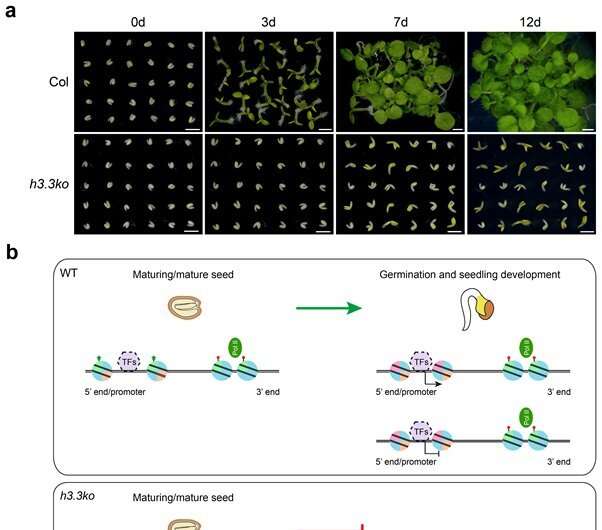Researchers reveal novel epigenetic mechanism in establishment of seed vigor

In plants, producing highly vigorous seeds capable of germinating and establishing seedlings is vital for their propagation and is a valuable trait in crops. Plant seeds obtain germination capacity during the late seed maturation stage. However, it is not known how the germination and post-embryonic developmental competence is established.
Epigenetic reprogramming is a highly temporal and spatial process essential for cellular differentiation and developmental transition in animals and plants. Researchers led by Dr. Jiang Danhua from the Institute of Genetics and Developmental Biology (IGDB) of the Chinese Academy of Sciences (CAS) found that the incorporation of a histone variant H3.3 into the chromatin is key to the formation of germination and post-embryonic developmental capacity in seeds.
In this study, they found that a complete loss of H3.3 in Arabidopsis thaliana strongly impairs seed germination and the following seedling development, even though it does not apparently affect seed formation.
Further analyses revealed that H3.3 is highly expressed toward the end of seed maturation and its expression at this stage is essential and sufficient for seed germination.
They then showed that a temporal deposition of H3.3 at the 5' gene regulatory regions in mature seed establishes chromatin accessibility that prefigures transcriptional competence for germination and post-embryonic development genes.
Intriguingly, although H3.3 is gradually removed from the 5' gene ends during germination, gene transcription competence established by H3.3 is maintained by sustained chromatin access likely to transcription factors.
They also found that H3.3 is constantly loaded at the 3' gene ends, correlating with gene body DNA methylation and the restriction of chromatin accessibility and cryptic transcription at this region.
Their findings uncover an epigenetic mechanism that "unlocks" the post-embryonic developmental potentials in mature seeds. It will provide a foundation for the further investigation of seed vigor, a less well-studied field especially at the molecular level, but critically important for agriculture and the seed industry.
This work entitled "Histone H3.3 deposition in seed is essential for the post-embryonic developmental competence in Arabidopsis" was published in Nature Communications on December 13.
More information: Ting Zhao et al, Histone H3.3 deposition in seed is essential for the post-embryonic developmental competence in Arabidopsis, Nature Communications (2022). DOI: 10.1038/s41467-022-35509-6
Journal information: Nature Communications
Provided by Chinese Academy of Sciences




















